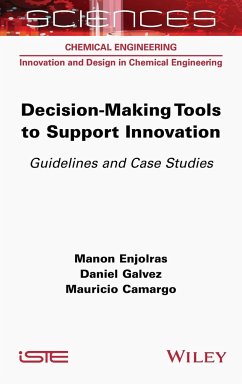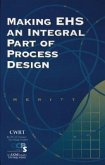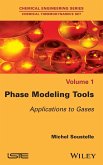Decision-Making Tools to Support Innovation
Guidelines and Case Studies
Herausgeber: Enjolras, Manon; Camargo, Mauricio; Galvez, Daniel
Decision-Making Tools to Support Innovation
Guidelines and Case Studies
Herausgeber: Enjolras, Manon; Camargo, Mauricio; Galvez, Daniel
- Gebundenes Buch
- Merkliste
- Auf die Merkliste
- Bewerten Bewerten
- Teilen
- Produkt teilen
- Produkterinnerung
- Produkterinnerung
Scientific thinking concerning the way in which we drive innovation has been widely developed in recent years. It is known that the process of innovation consists of a succession of decision-making processes that require simultaneous technical, economical, organizational and sustainable compromises. Indeed, all innovative activities in business require stakeholders to seek out the best compromise between various, often contradictory dimensions of the same problems. Through studying practical cases from various fields (e.g. energy, marketing and sustainable development), this book addresses all…mehr
![Making EHS an Integral Part of Process Design Making EHS an Integral Part of Process Design]() Arthur D Little IncMaking EHS an Integral Part of Process Design138,99 €
Arthur D Little IncMaking EHS an Integral Part of Process Design138,99 €![Statistical Tools for the Comprehensive Practice of Industrial Hygiene and Environmental Health Sciences Statistical Tools for the Comprehensive Practice of Industrial Hygiene and Environmental Health Sciences]() David L JohnsonStatistical Tools for the Comprehensive Practice of Industrial Hygiene and Environmental Health Sciences122,99 €
David L JohnsonStatistical Tools for the Comprehensive Practice of Industrial Hygiene and Environmental Health Sciences122,99 €![Simulation and Wargaming Simulation and Wargaming]() Simulation and Wargaming160,99 €
Simulation and Wargaming160,99 €![Phase Modeling Tools Phase Modeling Tools]() Michel SoustellePhase Modeling Tools189,99 €
Michel SoustellePhase Modeling Tools189,99 €![Metal Oxides as Support Materials for Electrocatalysts in Fuel Cells Metal Oxides as Support Materials for Electrocatalysts in Fuel Cells]() G. Venkata RameshMetal Oxides as Support Materials for Electrocatalysts in Fuel Cells29,99 €
G. Venkata RameshMetal Oxides as Support Materials for Electrocatalysts in Fuel Cells29,99 €![Making and Exploiting Fullerenes, Graphene, and Carbon Nanotubes Making and Exploiting Fullerenes, Graphene, and Carbon Nanotubes]() Making and Exploiting Fullerenes, Graphene, and Carbon Nanotubes147,99 €
Making and Exploiting Fullerenes, Graphene, and Carbon Nanotubes147,99 €![Making and Exploiting Fullerenes, Graphene, and Carbon Nanotubes Making and Exploiting Fullerenes, Graphene, and Carbon Nanotubes]() Making and Exploiting Fullerenes, Graphene, and Carbon Nanotubes147,99 €
Making and Exploiting Fullerenes, Graphene, and Carbon Nanotubes147,99 €-
-
-
Hinweis: Dieser Artikel kann nur an eine deutsche Lieferadresse ausgeliefert werden.
- Produktdetails
- Verlag: Wiley
- Seitenzahl: 272
- Erscheinungstermin: 29. August 2023
- Englisch
- Abmessung: 240mm x 161mm x 19mm
- Gewicht: 577g
- ISBN-13: 9781789450897
- ISBN-10: 1789450896
- Artikelnr.: 68365154
- Herstellerkennzeichnung
- Libri GmbH
- Europaallee 1
- 36244 Bad Hersfeld
- 06621 890
- Verlag: Wiley
- Seitenzahl: 272
- Erscheinungstermin: 29. August 2023
- Englisch
- Abmessung: 240mm x 161mm x 19mm
- Gewicht: 577g
- ISBN-13: 9781789450897
- ISBN-10: 1789450896
- Artikelnr.: 68365154
- Herstellerkennzeichnung
- Libri GmbH
- Europaallee 1
- 36244 Bad Hersfeld
- 06621 890
Christian FONTEIX
Introduction xiii
Chapter 1 The Selection of Ideas During a Creativity Workshop: An
Application of PROMETHEE 1
1.1 Context and challenges in decision-making 2
1.1.1 The phases of a creative workshop 2
1.1.2 Evaluation and selection of ideas 4
1.2 The PROMETHEE method 9
1.2.1 Methodological concept: the preference function 10
1.2.2 Application process 14
1.3 Application of PROMETHEE to the selection of ideas 16
1.3.1 Context of the workshop 16
1.3.2 Discussion of the results 22
1.4 To go further 23
1.4.1 The Gaia plane 23
1.4.2 Regarding the different versions of PROMETHEE 25
1.5 The PROMETHEE method: instructions for use 26
1.5.1 PROMETHEE step by step 26
1.5.2 Application of PROMETHEE with software support 32
1.6 References 39
Chapter 2 The Upstream Phases of Product Design: An Application of AHP 43
2.1 Context and challenges in decision-making 44
2.1.1 The challenges of the upstream phases of the design process 44
2.1.2 A trend in innovation: sustainable design 45
2.1.3 Definition of the decision model 46
2.2 The AHP method: analytic hierarchy process 49
2.2.1 The fundamental principle: the relative importance of criteria 49
2.2.2 Application of the method 54
2.3 Going further: the question of interdependence between criteria 62
2.3.1 The Dematel method 63
2.3.2 Application to the case study 67
2.3.3 Proposal for an AHP/Dematel combined approach 68
2.4 AHP: instructions for use 72
2.4.1 Practical guide 72
2.4.2 Illustration of related free software 78
2.5 References 83
Chapter 3 Marketing Strategy During the Market Entry Phase: An Application
of Rough Sets 85
3.1 Context and challenges in decision-making 86
3.1.1 Decision-making in marketing 86
3.1.2 Definition of the decision model 88
3.2 The Rough Sets method or the theory of approximate sets 90
3.2.1 Terminology 90
3.2.2 Fundamental principle: indiscernibility 91
3.2.3 Application of the method 93
3.3 Discussion of the results obtained 96
3.3.1 Conditional rules obtained 96
3.3.2 Operational exploitation of rules 98
3.3.3 To go further: dominance-based rough sets approach 100
3.4 The Rough Sets method: instructions for use 103
3.4.1 The case of extracting information from a database: an example using
the freeware program 4Emka 103
3.4.2 The case of implicit preference modeling 108
3.4.3 Step-by-step application 109
3.5 References 120
Chapter 4 Building a Coherent Project Portfolio: An Application of MAUT 123
4.1 Context and challenges in decision-making 124
4.1.1 The selection of innovative projects 124
4.1.2 Decision-making in the petroleum industry 124
4.1.3 Definition of the decision model 126
4.2 The MAUT method 127
4.2.1 Terminology and methodological concepts 127
4.2.2 Application of the method 130
4.3 To go further 138
4.3.1 Consideration of the constraints in making the decision 138
4.3.2 Synergies between criteria/between projects 139
4.3.3 The accuracy of the utility function 141
4.4 The MAUT method: instructions for use 141
4.4.1 MAUT step by step 141
4.4.2 Using software supports 149
4.5 References 154
Chapter 5 The Recruitment Process in Human Resources: An Application of
ELECTRE 157
5.1 Context and challenges in decision-making 158
5.1.1 Human resources management and innovation 158
5.1.2 The challenges of the recruitment process 159
5.2 The ELECTRE method 161
5.2.1 Methodological concepts 161
5.2.2 Application of ELECTRE to the hiring of new staff members 164
5.3 To go further 173
5.3.1 Addressing incomparability in the results 173
5.3.2 Improving the accuracy of input data: processing qualitative criteria
177
5.4 ELECTRE: instructions for use 178
5.4.1 Practical guide 179
5.4.2 Illustration of related free software 187
5.5 References 190
Chapter 6 Knowledge Management in the Supply Chain: An Application of
TOPSIS 193
6.1 Context and challenges in decision-making 194
6.1.1 Knowledge management in the supply chain 194
6.1.2 Definition of the decision model 196
6.2 The TOPSIS method 199
6.2.1 Methodological concepts 200
6.2.2 Application of the method 204
6.3 To go further 213
6.3.1 The imprecise nature of human judgment: moving towards "fuzzy logic"
213
6.3.2 Sensitivity analysis or the proposal of simulation scenarios 216
6.4 The TOPSIS method: instructions for use 218
6.4.1 TOPSIS step by step 218
6.4.2 Illustration of related free software 225
6.5 References 229
Conclusion 231
List of Authors 237
Index 239
Christian FONTEIX
Introduction xiii
Chapter 1 The Selection of Ideas During a Creativity Workshop: An
Application of PROMETHEE 1
1.1 Context and challenges in decision-making 2
1.1.1 The phases of a creative workshop 2
1.1.2 Evaluation and selection of ideas 4
1.2 The PROMETHEE method 9
1.2.1 Methodological concept: the preference function 10
1.2.2 Application process 14
1.3 Application of PROMETHEE to the selection of ideas 16
1.3.1 Context of the workshop 16
1.3.2 Discussion of the results 22
1.4 To go further 23
1.4.1 The Gaia plane 23
1.4.2 Regarding the different versions of PROMETHEE 25
1.5 The PROMETHEE method: instructions for use 26
1.5.1 PROMETHEE step by step 26
1.5.2 Application of PROMETHEE with software support 32
1.6 References 39
Chapter 2 The Upstream Phases of Product Design: An Application of AHP 43
2.1 Context and challenges in decision-making 44
2.1.1 The challenges of the upstream phases of the design process 44
2.1.2 A trend in innovation: sustainable design 45
2.1.3 Definition of the decision model 46
2.2 The AHP method: analytic hierarchy process 49
2.2.1 The fundamental principle: the relative importance of criteria 49
2.2.2 Application of the method 54
2.3 Going further: the question of interdependence between criteria 62
2.3.1 The Dematel method 63
2.3.2 Application to the case study 67
2.3.3 Proposal for an AHP/Dematel combined approach 68
2.4 AHP: instructions for use 72
2.4.1 Practical guide 72
2.4.2 Illustration of related free software 78
2.5 References 83
Chapter 3 Marketing Strategy During the Market Entry Phase: An Application
of Rough Sets 85
3.1 Context and challenges in decision-making 86
3.1.1 Decision-making in marketing 86
3.1.2 Definition of the decision model 88
3.2 The Rough Sets method or the theory of approximate sets 90
3.2.1 Terminology 90
3.2.2 Fundamental principle: indiscernibility 91
3.2.3 Application of the method 93
3.3 Discussion of the results obtained 96
3.3.1 Conditional rules obtained 96
3.3.2 Operational exploitation of rules 98
3.3.3 To go further: dominance-based rough sets approach 100
3.4 The Rough Sets method: instructions for use 103
3.4.1 The case of extracting information from a database: an example using
the freeware program 4Emka 103
3.4.2 The case of implicit preference modeling 108
3.4.3 Step-by-step application 109
3.5 References 120
Chapter 4 Building a Coherent Project Portfolio: An Application of MAUT 123
4.1 Context and challenges in decision-making 124
4.1.1 The selection of innovative projects 124
4.1.2 Decision-making in the petroleum industry 124
4.1.3 Definition of the decision model 126
4.2 The MAUT method 127
4.2.1 Terminology and methodological concepts 127
4.2.2 Application of the method 130
4.3 To go further 138
4.3.1 Consideration of the constraints in making the decision 138
4.3.2 Synergies between criteria/between projects 139
4.3.3 The accuracy of the utility function 141
4.4 The MAUT method: instructions for use 141
4.4.1 MAUT step by step 141
4.4.2 Using software supports 149
4.5 References 154
Chapter 5 The Recruitment Process in Human Resources: An Application of
ELECTRE 157
5.1 Context and challenges in decision-making 158
5.1.1 Human resources management and innovation 158
5.1.2 The challenges of the recruitment process 159
5.2 The ELECTRE method 161
5.2.1 Methodological concepts 161
5.2.2 Application of ELECTRE to the hiring of new staff members 164
5.3 To go further 173
5.3.1 Addressing incomparability in the results 173
5.3.2 Improving the accuracy of input data: processing qualitative criteria
177
5.4 ELECTRE: instructions for use 178
5.4.1 Practical guide 179
5.4.2 Illustration of related free software 187
5.5 References 190
Chapter 6 Knowledge Management in the Supply Chain: An Application of
TOPSIS 193
6.1 Context and challenges in decision-making 194
6.1.1 Knowledge management in the supply chain 194
6.1.2 Definition of the decision model 196
6.2 The TOPSIS method 199
6.2.1 Methodological concepts 200
6.2.2 Application of the method 204
6.3 To go further 213
6.3.1 The imprecise nature of human judgment: moving towards "fuzzy logic"
213
6.3.2 Sensitivity analysis or the proposal of simulation scenarios 216
6.4 The TOPSIS method: instructions for use 218
6.4.1 TOPSIS step by step 218
6.4.2 Illustration of related free software 225
6.5 References 229
Conclusion 231
List of Authors 237
Index 239








